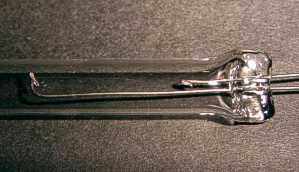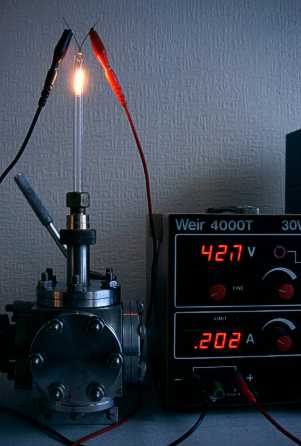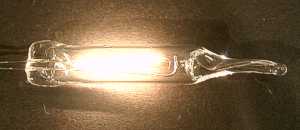 Crimp a length of 0.025mm diameter tungsten wire between the two hooked ends of the
Ni48/Fe52 wire. The filament in the picture is 21mm long.
Crimp a length of 0.025mm diameter tungsten wire between the two hooked ends of the
Ni48/Fe52 wire. The filament in the picture is 21mm long.
| Previous Page | Glass Blowing Menu | Main Menu | Next Page |
|---|
This is the simplest filament lamp that I have made. No glass joining or bulb blowing is required.
Start with a length of 8mm diameter thin wall glass tube and a 120mm length of 0.5mm diameter Ni48/Fe52 wire. The tube length is not critical, but it must be at least 120mm to allow for mounting on the pump and sealing off. Fold the wire so that one length is 48mm and the other is 72mm. Bend each end over into a small hook using pliers. Bend the last 4mm of the longer length into a right-angle.
 Crimp a length of 0.025mm diameter tungsten wire between the two hooked ends of the
Ni48/Fe52 wire. The filament in the picture is 21mm long.
Crimp a length of 0.025mm diameter tungsten wire between the two hooked ends of the
Ni48/Fe52 wire. The filament in the picture is 21mm long.
 The wires are sealed into the end of the tube in the same way as is described on the
Panel Neon page. The wires tend to warp a little during sealing in, leaving the
filament a little slack. Care must be taken to ensure that the filament does not
end up touching the wall of the tube.
The wires are sealed into the end of the tube in the same way as is described on the
Panel Neon page. The wires tend to warp a little during sealing in, leaving the
filament a little slack. Care must be taken to ensure that the filament does not
end up touching the wall of the tube.
The end of the tube must be annealed in the sooty flame, insulated and then allowed to
cool slowly.
 0.025mm diameter tungsten wire can be safely operated at 200mA in a vacuum. This lamp
requires 4.3V for 200mA to flow, giving 860mW.
0.025mm diameter tungsten wire can be safely operated at 200mA in a vacuum. This lamp
requires 4.3V for 200mA to flow, giving 860mW.
The lamp is sealed off in the same way as has been described previously. If the lamp
fails to operate at 200mA after seal-off, look for cracks. That is the usual cause.
The very uneven thickness at both ends of the lamp makes it cool unevenly. This causes
great stress within the glass. This makes annealing and insulation during cooling
particularly important.
 The completed lamp running at 200mA.
The completed lamp running at 200mA.
| Previous Page | Glass Blowing Menu | Main Menu | Next Page |
|---|